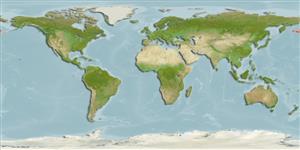Classification / Names
आम नाम | उपशब्द | Catalog of Fishes(वर्ग, प्रजाति) | ITIS | CoL | WoRMS | Cloffa
>
Perciformes/Cottoidei (Sculpins) >
Liparidae (Snailfishes)
Etymology: Careproctus: Greek, kara = face + Greek, proktos = anus (Ref. 45335); zachirus: Named for the long pectoral fin..
Environment: milieu / climate zone / depth range / distribution range
पारिस्थितिकी
समुद्री बाथीड़िमरसल; गहराई सीमा 150 - 850 m (Ref. 51661), usually 400 - 500 m (Ref. 56456). Deep-water
Northwest Pacific: Amchatka Pass, Alaska.
आकार / वज़न / Age
Maturity: Lm ? range ? - ? cm
Max length : 32.0 cm TL पुल्लिंग / अलिंग; (Ref. 56456); common length : 22.0 cm TL पुल्लिंग / अलिंग; (Ref. 56456); अधिकतम प्रकाशित वज़न: 500.00 g (Ref. 56456); अधिकतम सूचित उम्र: 7 वर्षो (Ref. 56456)
Short description
आकृति विज्ञान | मौरफोमैटरिक्स
पृष्ठीय रीढ़ (सम्पूर्ण): 0; पृष्ठीय सौफट रेज़ (सम्पूर्ण): 51-53; गुदा कांटा 0; ऐनल सौफट रेज़: 43 - 45; जानवरों की रीड़ का जोड़: 56 - 58. Pectoral fin distinctly notched; caudal fin broad, continuous with dorsal and anal fins for about two-thirds of its length, end of dorsal fin forming notch on caudal fin (Ref. 12700). Body pinkish; eye black; posterior part of upper pectoral fin lobe stained with black in both outer and inner sides; black bands of dorsal and anal fins jointed each other in the middle of the caudal fin (Ref. 12700).
Life cycle and mating behavior
परिपक्व अवधि | पुनरुत्पत्ति | मछलीऔ का अंडे देना | अंडे | Fecundity | लार्वा
Kido, K., 1985. New and rare species of the genus Careproctus (Liparididae) from the Bering Sea. Jap. J. Ichthyol. 32(1):6-17. (Ref. 12700)
IUCN Red List Status (Ref. 130435)
Threat to humans
Harmless
Human uses
मात्स्यिकी: कोई रुचि बग़ैर
अधिक जानकारी
आम नामउपशब्दचपायचयपरभक्षीईकोटोकसीकोलौजीपुनरुत्पत्तिपरिपक्व अवधिमछलीऔ का अंडे देनाSpawning aggregationFecundityअंडेEgg development
संदर्भजलीयकृषिजलीयकृषि रूपरेखाखींचआनुवंशिकीElectrophoresesहैरेटिबिलटीबीमारीप्रक्रमणNutrientsMass conversion
सहयोगीयोतस्वीरेStamps, Coins Misc.ध्वनिसिगुयटिरारफ्तारतैरने के प्रकारगिल क्षेत्रOtolithsदिमागदृष्टि
साधन
Special reports
Download XML
इंटरनेट स्रोत
Estimates based on models
Preferred temperature (Ref.
123201): 3.2 - 3.6, mean 3.5 °C (based on 7 cells).
Phylogenetic diversity index (Ref.
82804): PD
50 = 0.5000 [Uniqueness, from 0.5 = low to 2.0 = high].
Bayesian length-weight: a=0.00692 (0.00380 - 0.01261), b=3.14 (2.98 - 3.30), in cm total length, based on LWR estimates for this species & Genus-body shape (Ref.
93245).
Trophic level (Ref.
69278): 3.4 ±0.47 se; based on food items.
लौटाव (Ref.
120179): माध्यम, न्यूनतम जनसंख्या दुगनी होने का समय 1.4 - 4.4 वर्ष। (Preliminary K or Fecundity.).
Fishing Vulnerability (Ref.
59153): Low vulnerability (22 of 100).
